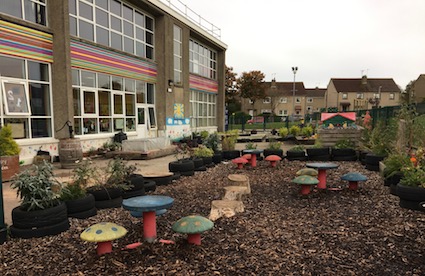
Back in 2011 a couple of my blog posts featured Westpark School Nursery in Aberdeen – the ones about masking tape and blue tarp on a windy day. At that time, the outdoor space was sparse – an expanse of asphalt, a patch of blue wet pour surfacing in one corner with a few seats and a slide, as shown in the photo below.

Since 2013, with the arrival of a principal teacher, Gregor Watson, this area has undergone an evolution. By this I mean that bit-by-bit, little-by-little, the place has changed. It began with a couple of raised beds made with sleepers bought at a discounted price through the husband of a teacher. One of these is now a cold frame where winter vegetables have been planted. The other is a mud area.

Four years ago, the children were really interested in fairies, a large old raised bed donated by the local council environmental department became a fairy garden. I blogged about the literacy possibilities of this small world area back in May 2014.

The fairy garden remains much-loved and popular with the children so it has never morphed into anything else. The features have changed and the area has that feeling of being and belonging to the space.
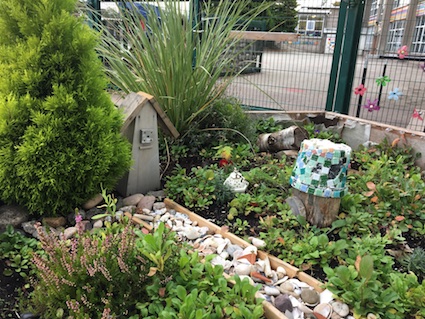
The nursery is based in one of the poorer areas of Aberdeen. Prior to 2013, the staff used to set up and put away the resources on a daily basis. The main concerns were those of theft and vandalism.
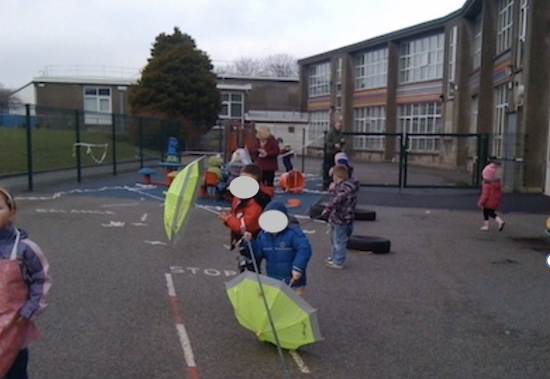
However the gentle evolution seems to be working. Whilst there is some vandalism, particularly over the holidays, it is fairly minor. The staff take a sensible approach to this happening. For example, greatest developments have happened where the CCTV cameras and nearby housing can see what’s happening. The area further away is more prone to vandalism so this has been deliberately less developed.
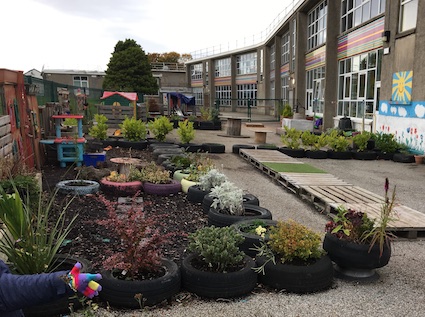
The bird feeding station below is constantly being adapted, refined and changed. You will see this in the video at the bottom of the blog post (well worth a look).

Everything is securely fastened down or really heavy and a bit of a nuisance to move. So using tyres filled with soil is not only economical, they are left alone and work really well for zoning the outdoor space. it has enabled the children to make better choices in their play and also facilitated some pockets of creativity.
If you look closely at the pallet above you can see it is a massive bird feeding station. Birds visit a lot, especially pigeons who are not perturbed by the presence of children. Opposite the bird station, a hide has been set up in the classroom so that children can watch the birds from inside too.
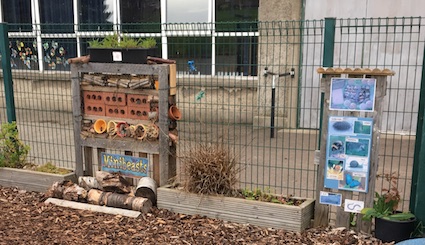
There’s a couple of minibeast investigation areas. These were created with the children a couple of years ago because they were so fascinated with finding little creatures. In the photo above, the mini beast area although it looks bonny, it doesn’t have the numbers and variety of mini beasts found in the log piles beside the compost bin.

This is to be expected. The compost bin provides a source of additional food and shelter for worms and grubs of various sorts. The plants attract flying insects and the diversity within the small space is much greater. If you are interested in creating habitats then check out this blog post on log piles, this one about minibeast hotels and this one about other simple minibeast habitats that are easy to create.

The decking area houses a donated little house and homemade reading shack. It’s always tempting to throw out plastic objects or donate them to charity, but finding alternative uses can demonstrate making the most of what you have. By surrounding the house with pallet it helped make the plastic house snug and less prominent within the space.
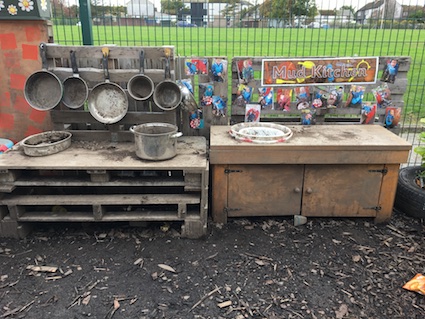
The mud kitchen area is also a fun mix. The kitchen unit on the right is a Cosy product which is bearing up well. On the left is a pallet play area. The floor is good mix of topsoil and bark chips, with more available in nearby tyres.
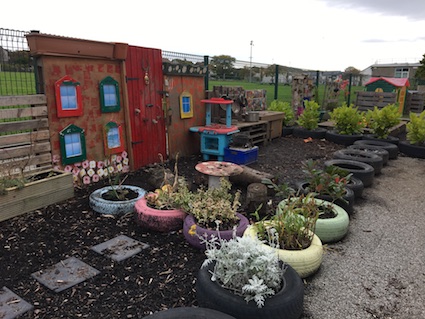
Another lovely feature was the donated red door. Initially it could be opened but the children kept squashing each other behind the door. So instead, lots of locks, bolts, knockers and other door attachments were added, including a couple of old trolley wheels.

I hope this has given you a flavour of this space and that it encourages you to continually seek your children’s ideas and input into evolving your own outdoor space and practice. Many thanks to Westpark School Nursery for enabling me to visit and catch up on their happenings. In particular, early years practitioner, Sharon Horne has been the amazing at finding, learning and developing so much of the outdoor space.
In September 2020 we made this video which helps bring the changes identified in this blog post to life. Please note, since this video and the blog post was written, there have been changes to staffing and also outdoor provision – mainly around the securing of loose parts at night time.






























Excellent work at Westpark
Totally impressed and motivated. Well done everyone!
Thank you for sharing!